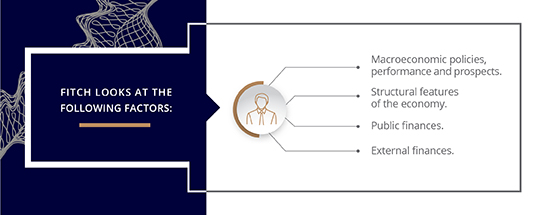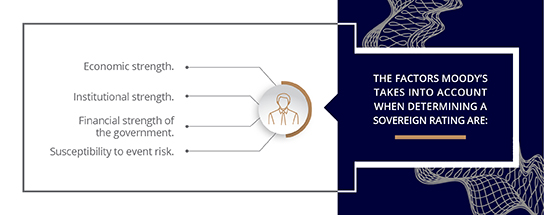Sovereign ratings: how is South Africa assessed?

Every time South Africa receives a change in sovereign ratings from one of the credit ratings agencies, it seems to send markets and investors alike into a little bit of a frenzy. But how do credit agencies measure a sovereign rating and what effect does this really have on a country?
What is a sovereign default rating?
A credit rating measures the relative risk that an entity or transaction will fail to meet its financial commitments, such as interest payments and repayment of principal, on a timely basis. A sovereign or a country is typically deemed to default when it fails to make timely payment of principal or interest on its publicly issued debt, or if it offers a distressed exchange for the original debt. A distressed exchange refers to a situation where creditors accept less than the original promise because of the risk that the issuer will otherwise fail to meet its original obligations. Default events do not usually include the failure to repay debt owed to other governments and official creditors, including the IMF and World Bank.
The three major ratings agencies are Standard & Poor’s (S&P), Moody's and Fitch. S&P measures default risk in terms of default probability. Moody's ratings measure expected loss. This refers to the probability of default and the expected severity of loss in the event of a default. Fitch rates issuers on a default probability basis and instruments on an expected loss basis. So, in theory, Moody's ratings should diverge from Fitch's and S&P's according to variations in loss severity. Loss severity is the portion of a bond's value including unpaid interest an investor loses in the event of default.
What do the ratings mean?
From the most creditworthy to the least, Fitch and S&P use AAA, AA, A, and BBB for investment-grade long-term credit risk, and BB, B, CCC, CC, C, and D for "speculative" long-term credit risk. Moody's goes from Aaa for the highest quality credit risk down to Aa1 and Aa2, moving through to C and D for "near bankruptcy or default".
Credit ratings agencies typically signal in advance their intention to consider rating changes. For example, Fitch, Moody's, and S&P all use negative "review" or "watch" notifications to indicate that a downgrade is likely within the next 90 days. They use a negative "outlook" notification to indicate the potential for a downgrade within the next two years.
If a country is downgraded by a credit rating agency, lenders are less keen to buy the country's bonds and will ask for better terms (a higher interest rate, or earlier repayment) than they would have done previously. This makes it more expensive for a government to borrow.
The knock-on effect for other borrowers, such as banks and large companies, is that they also have to pay higher interest rates if they want to borrow from foreign investors.
What factors are taken into account?
Gardner Rusike, Sovereign Analyst at Standard & Poor’s (S&P), says when Standard & Poors calculates sovereign ratings or measures default probability, the following five assessments come into play:
- Institutional: This assessment reflects the agency’s view of how a government's institutions and policymaking affect a sovereign's credit fundamentals by delivering sustainable public finances, promoting balanced economic growth, and responding to economic or political shocks.
- Economic: This incorporates the agency’s view of the country's income levels as measured by its GDP per capita, indicating broader potential tax and funding bases upon which to draw, which generally support creditworthiness; growth prospects; and its economic diversity and volatility.
- Fiscal: This reflects the agency’s view of the sustainability of a sovereign's deficits and its debt burden. This measure considers fiscal flexibility, long-term fiscal trends and vulnerabilities, debt structure and funding access, and potential risks arising from contingent liabilities.
- External: This is primarily driven by the agency’s view of:
- The status of a sovereign's currency in international transactions;
- The country's external liquidity, which provides an indication of the economy's ability to generate the foreign exchange necessary to meet its public- and private-sector obligations to non-residents; and
- The country's external position, which shows residents' assets and liabilities (in both foreign and local currency) relative to the rest of the world.
- Monetary: The credibility of monetary policy as measured, among other factors, by inflation trends over an economic cycle and the effects of market-oriented monetary mechanisms on the real economy, which is largely a function of the depth and diversification of a country's financial system and capital markets.


The challenge for South Africa
Speaking at a Standard & Poor’s conference in Cape Town, Rusike said the South African current account deficit is at its lowest level in years. “The challenge in South Africa is about persistent current account deficits that are predominantly funded by volatile portfolio flows. So, in the current circumstances of lower current account deficits, below 3% of GDP, the financing challenge is less so than it is when the current account deficits are significantly larger, perhaps about 5% or as high as 7% as we have seen in previous years,” he noted.
Action speaks louder than words
Two factors that could affect South Africa’s sovereign rating positively are:
- Higher economic performance- S&P could take a positive rating action if economic growth or fiscal outcomes strengthen in a significant and sustained manner.
- Government reforms: “We could take a positive rating action if policymakers were to introduce structural economic reforms that delivered improved competitiveness and employment”. Rusike cautions that political changes on their own do not necessarily result in a ratings change. “It is what happens after the political transition in terms of the reforms that are introduced by the new leadership and the economic impact of those reforms that could subsequently result in potential changes in the country’s ratings trajectory,” he says.
Downside pressure on South Africa’s rating could develop if:
- Fiscal performance were to deteriorate either due to higher expenditure pressures or weaker economic performance than S&P forecasts.
- The rule of law, property rights, or enforcement of contracts were to weaken, undermining the investment and economic outlook.
South Africa rated “stable”
At the time of writing this article, S&P had just reaffirmed South Africa’s credit rating as “stable”, holding its credit rating on SA government bonds (rand-denominated) at one tier into junk status, BB+. Foreign currency bonds were held at two tiers into junk status, BB.
“We anticipate a pick-up in private-sector fixed investment‚ while lower inflation could boost households’ disposable income‚ resulting in higher household consumption. We now estimate economic growth to average at least 2% over 2018–21‚ which is still below 1% per capita. We estimate that among the 20 major emerging markets‚ only Qatar will show slower per capita growth in 2018. We estimate SA’s GDP per capita at $7‚200 in 2018‚” the report said.
In March 2018, Moody’s had also decided to keep SA at “investment grade”. At the time the rating agency said it was of the opinion that the previous weakening of South Africa's institutions would "gradually reverse under [the] more transparent and predictable policy framework" of President Cyril Ramaphosa. Going back further to November 2017, Fitch revealed it would keep South Africa's long-term foreign and local currency debt ratings at ‘BB+’ - commonly known as "junk" - with a stable outlook.
Personal Finance – 10 things you should know about credit ratings
S&P conference: Navigating SA's credit landscape in changing times
International Monetary Fund: The uses and abuses of sovereign credit ratings.
www.fin24.com: www.fin24.com/Economy/sa-dodges-moodys-credit-rating-downgrade-20160508
World Bank
Disclaimer
This article is meant only as information and should not be taken as financial advice. For tailored financial advice, please contact your financial adviser. Discovery Life Investment Services Pty (Ltd): Registration number 2007/005969/07, branded as Discovery Invest, is an authorised financial services provider.